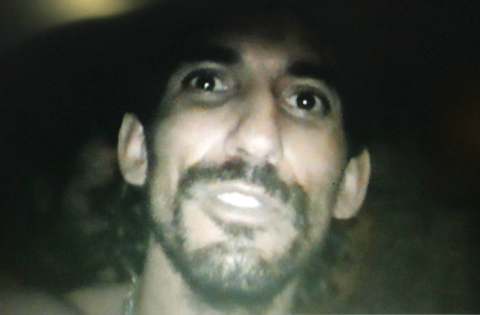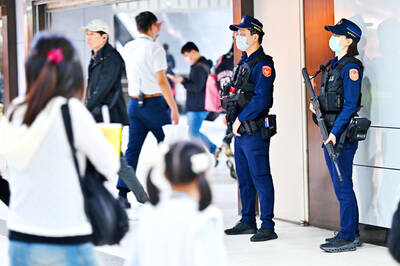A new video released on Sunday of 33 men trapped in a mine under Chile’s Atacama Desert shows them sending greetings to their families, talking about how they are doing better since receiving food and breaking into tears as they talk about loved ones.
In the video, the men are shirtless because of the heat in the mine and wear what look like white surgical pants, special clothing sent down to help keep them dry.
Most are upbeat, expressing gratitude to their families and the rescuers for the support they are receiving via handwritten notes sent to them through three small bore holes. Authorities also sent food, water, medicine and other goods to them through the three holes.

PHOTO: EPA
However, when it comes time to speak about their wives and children, many of the men break down.
“I’m sending my greetings to Angelica. I love you so much, darling,” said 30-year-old Osman Araya, as his voice chokes and he begins to cry. “Tell my mother, I love you guys so much. I’ll never leave you, I will fight to the end to be with you.”
Araya and 32 fellow miners were trapped by the Aug. 5 collapse of the main shaft of the San Jose gold and silver mine in northern Chile. They only gained contact with the outside after 17 days — during which they rationed 48-hours worth of food and dug for water in the ground. Yesterday, the men equaled a mark set by three miners who survived 25 days trapped in a flooded mine in southern China last year. Few other rescues have taken more than two weeks.
One miner explains to the family of 28-year-old Ariel Ticona that he didn’t want to appear on camera — apparently because he is shy — but that he was sending his love to them and that, according to an unidentified speaker, he “is super happy and he is super, super, super well!”
The video, in contrast to the first 45-minute video released by the government on Thursday last week, shows little of the men’s surroundings.
Instead, it appears meant as a video postcard for loved ones, as each of the 12 men who speak to the camera are given about 30 seconds to talk.
At one point, the camera pans to a larger group of men, and several animated, joking voices can be heard throughout the tape.
One unidentified man, who squints in the light shone on his face, as do most of the miners, said he was thankful “for all your efforts out there.”
One man shown says he is doing much better because of the food and water the miners have received.
Throughout the interviews, as the men start to choke up when speaking about their families, a voice behind the camera urges them on.
“Let’s go, let’s go, you can do it,” the unidentified man said.

TRAGEDY STRIKES TAIPEI: The suspect died after falling off a building after he threw smoke grenades into Taipei Main Station and went on a killing spree in Zhongshan A 27-year-old suspect allegedly threw smoke grenades in Taipei Main Station and then proceeded to Zhongshan MRT Station in a random killing spree that resulted in the death of the suspect and two other civilians, and seven injured, including one in critical condition, as of press time last night. The suspect, identified as a man surnamed Chang Wen (張文), allegedly began the attack at Taipei Main Station, the Taipei Fire Department said, adding that it received a report at 5:24pm that smoke grenades had been thrown in the station. One man in his 50s was rushed to hospital after a cardiac arrest

SAFETY FIRST: Double the number of police were deployed at the Taipei Marathon, while other cities released plans to bolster public event safety Authorities across Taiwan have stepped up security measures ahead of Christmas and New Year events, following a knife and smoke bomb attack in Taipei on Friday that left four people dead and 11 injured. In a bid to prevent potential copycat incidents, police deployments have been expanded for large gatherings, transport hubs, and other crowded public spaces, according to official statements from police and city authorities. Taipei Mayor Chiang Wan-an (蔣萬安) said the city has “comprehensively raised security readiness” in crowded areas, increased police deployments with armed officers, and intensified patrols during weekends and nighttime hours. For large-scale events, security checkpoints and explosives

A car bomb killed a senior Russian general in southern Moscow yesterday morning, the latest high-profile army figure to be blown up in a blast that came just hours after Russian and Ukrainian delegates held separate talks in Miami on a plan to end the war. Kyiv has not commented on the incident, but Russian investigators said they were probing whether the blast was “linked” to “Ukrainian special forces.” The attack was similar to other assassinations of generals and pro-war figures that have either been claimed, or are widely believed to have been orchestrated, by Ukraine. Russian Lieutenant General Fanil Sarvarov, 56, head

PUBLIC SAFETY: The premier said that security would be tightened in transport hubs, while President Lai commended the public for their bravery The government is to deploy more police, including rapid response units, in crowded public areas to ensure a swift response to any threats, President William Lai (賴清德) said yesterday after a knife attack killed three people and injured 11 in Taipei the previous day. Lai made the remarks following a briefing by the National Police Agency on the progress of the investigation, saying that the attack underscored the importance of cooperation in public security between the central and local governments. The attack unfolded in the early evening on Friday around Taipei Main Station’s M7 exit and later near the Taipei MRT’s Zhongshan